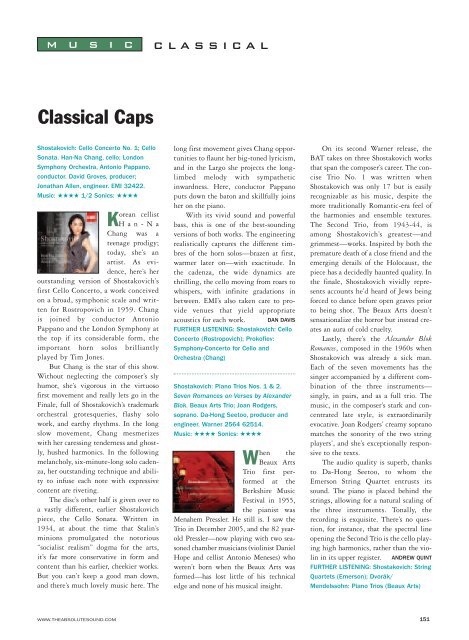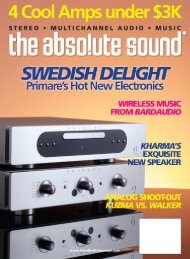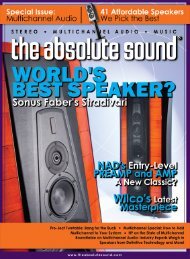in this issue
in this issue
in this issue
You also want an ePaper? Increase the reach of your titles
YUMPU automatically turns print PDFs into web optimized ePapers that Google loves.
m u s i c CLASSICAL<br />
Classical Caps<br />
Shostakovich: Cello Concerto No. 1; Cello<br />
Sonata. Han-Na Chang, cello; London<br />
Symphony Orchestra, Antonio Pappano,<br />
conductor. David Groves, producer;<br />
Jonathan Allen, eng<strong>in</strong>eer. EMI 32422.<br />
Music: ★★★★ 1/2 Sonics: ★★★★<br />
Korean cellist<br />
Han-Na<br />
Chang was a<br />
teenage prodigy;<br />
today, she’s an<br />
artist. As evidence,<br />
here’s her<br />
outstand<strong>in</strong>g version of Shostakovich’s<br />
first Cello Concerto, a work conceived<br />
on a broad, symphonic scale and written<br />
for Rostropovich <strong>in</strong> 1959. Chang<br />
is jo<strong>in</strong>ed by conductor Antonio<br />
Pappano and the London Symphony at<br />
the top if its considerable form, the<br />
important horn solos brilliantly<br />
played by Tim Jones.<br />
But Chang is the star of <strong>this</strong> show.<br />
Without neglect<strong>in</strong>g the composer’s sly<br />
humor, she’s vigorous <strong>in</strong> the virtuoso<br />
first movement and really lets go <strong>in</strong> the<br />
F<strong>in</strong>ale, full of Shostakovich’s trademark<br />
orchestral grotesqueries, flashy solo<br />
work, and earthy rhythms. In the long<br />
slow movement, Chang mesmerizes<br />
with her caress<strong>in</strong>g tenderness and ghostly,<br />
hushed harmonics. In the follow<strong>in</strong>g<br />
melancholy, six-m<strong>in</strong>ute-long solo cadenza,<br />
her outstand<strong>in</strong>g technique and ability<br />
to <strong>in</strong>fuse each note with expressive<br />
content are rivet<strong>in</strong>g.<br />
The disc’s other half is given over to<br />
a vastly different, earlier Shostakovich<br />
piece, the Cello Sonata. Written <strong>in</strong><br />
1934, at about the time that Stal<strong>in</strong>’s<br />
m<strong>in</strong>ions promulgated the notorious<br />
“socialist realism” dogma for the arts,<br />
it’s far more conservative <strong>in</strong> form and<br />
content than his earlier, cheekier works.<br />
But you can’t keep a good man down,<br />
and there’s much lovely music here. The<br />
long first movement gives Chang opportunities<br />
to flaunt her big-toned lyricism,<br />
and <strong>in</strong> the Largo she projects the longlimbed<br />
melody with sympathetic<br />
<strong>in</strong>wardness. Here, conductor Pappano<br />
puts down the baton and skillfully jo<strong>in</strong>s<br />
her on the piano.<br />
With its vivid sound and powerful<br />
bass, <strong>this</strong> is one of the best-sound<strong>in</strong>g<br />
versions of both works. The eng<strong>in</strong>eer<strong>in</strong>g<br />
realistically captures the different timbres<br />
of the horn solos—brazen at first,<br />
warmer later on—with exactitude. In<br />
the cadenza, the wide dynamics are<br />
thrill<strong>in</strong>g, the cello mov<strong>in</strong>g from roars to<br />
whispers, with <strong>in</strong>f<strong>in</strong>ite gradations <strong>in</strong><br />
between. EMI’s also taken care to provide<br />
venues that yield appropriate<br />
acoustics for each work. DAN DAVIS<br />
FURTHER LISTENING: Shostakovich: Cello<br />
Concerto (Rostropovich); Prokofiev:<br />
Symphony-Concerto for Cello and<br />
Orchestra (Chang)<br />
Shostakovich: Piano Trios Nos. 1 & 2.<br />
Seven Romances on Verses by Alexander<br />
Blok. Beaux Arts Trio; Joan Rodgers,<br />
soprano. Da-Hong Seetoo, producer and<br />
eng<strong>in</strong>eer. Warner 2564 62514.<br />
Music: ★★★★ Sonics: ★★★★<br />
When<br />
the<br />
Beaux Arts<br />
Trio first performed<br />
at the<br />
Berkshire Music<br />
Festival <strong>in</strong> 1955,<br />
the pianist was<br />
Menahem Pressler. He still is. I saw the<br />
Trio <strong>in</strong> December 2005, and the 82 yearold<br />
Pressler—now play<strong>in</strong>g with two seasoned<br />
chamber musicians (viol<strong>in</strong>ist Daniel<br />
Hope and cellist Antonio Meneses) who<br />
weren’t born when the Beaux Arts was<br />
formed—has lost little of his technical<br />
edge and none of his musical <strong>in</strong>sight.<br />
On its second Warner release, the<br />
BAT takes on three Shostakovich works<br />
that span the composer’s career. The concise<br />
Trio No. 1 was written when<br />
Shostakovich was only 17 but is easily<br />
recognizable as his music, despite the<br />
more traditionally Romantic-era feel of<br />
the harmonies and ensemble textures.<br />
The Second Trio, from 1943-44, is<br />
among Shostakovich’s greatest—and<br />
grimmest—works. Inspired by both the<br />
premature death of a close friend and the<br />
emerg<strong>in</strong>g details of the Holocaust, the<br />
piece has a decidedly haunted quality. In<br />
the f<strong>in</strong>ale, Shostakovich vividly represents<br />
accounts he’d heard of Jews be<strong>in</strong>g<br />
forced to dance before open graves prior<br />
to be<strong>in</strong>g shot. The Beaux Arts doesn’t<br />
sensationalize the horror but <strong>in</strong>stead creates<br />
an aura of cold cruelty.<br />
Lastly, there’s the Alexander Blok<br />
Romances, composed <strong>in</strong> the 1960s when<br />
Shostakovich was already a sick man.<br />
Each of the seven movements has the<br />
s<strong>in</strong>ger accompanied by a different comb<strong>in</strong>ation<br />
of the three <strong>in</strong>struments—<br />
s<strong>in</strong>gly, <strong>in</strong> pairs, and as a full trio. The<br />
music, <strong>in</strong> the composer’s stark and concentrated<br />
late style, is extraord<strong>in</strong>arily<br />
evocative. Joan Rodgers’ creamy soprano<br />
matches the sonority of the two str<strong>in</strong>g<br />
players’, and she’s exceptionally responsive<br />
to the texts.<br />
The audio quality is superb, thanks<br />
to Da-Hong Seetoo, to whom the<br />
Emerson Str<strong>in</strong>g Quartet entrusts its<br />
sound. The piano is placed beh<strong>in</strong>d the<br />
str<strong>in</strong>gs, allow<strong>in</strong>g for a natural scal<strong>in</strong>g of<br />
the three <strong>in</strong>struments. Tonally, the<br />
record<strong>in</strong>g is exquisite. There’s no question,<br />
for <strong>in</strong>stance, that the spectral l<strong>in</strong>e<br />
open<strong>in</strong>g the Second Trio is the cello play<strong>in</strong>g<br />
high harmonics, rather than the viol<strong>in</strong><br />
<strong>in</strong> its upper register. ANDREW QUINT<br />
FURTHER LISTENING: Shostakovich: Str<strong>in</strong>g<br />
Quartets (Emerson); Dvorák/<br />
Mendelssohn: Piano Trios (Beaux Arts)<br />
WWW.THEABSOLUTESOUND.COM 151










